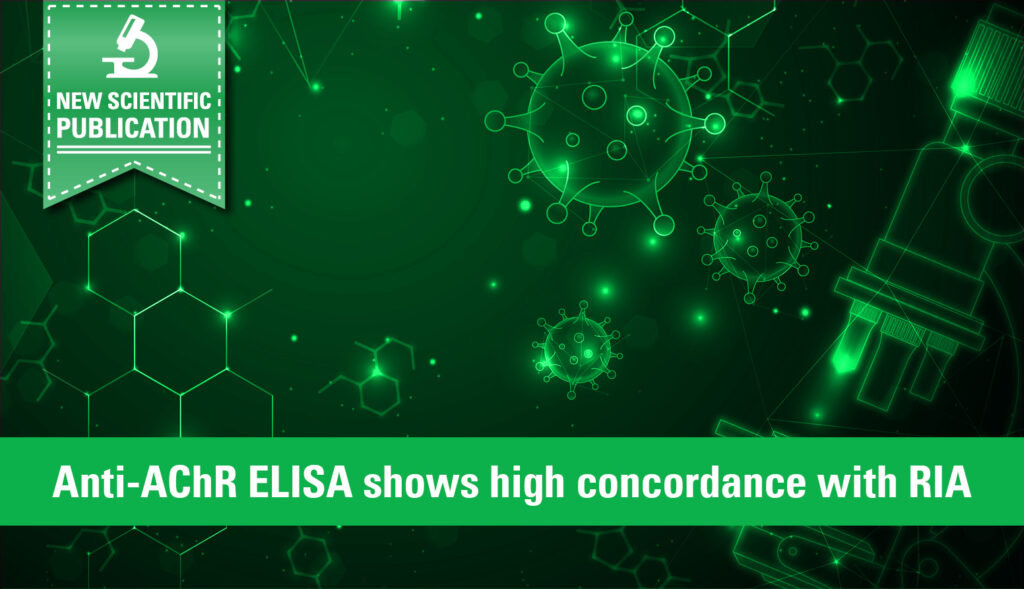The EUROIMMUN Anti-Acetylcholine Receptor ELISA shows a high overall concordance with traditional radioimmunoassay (RIA) in patients with myasthenia gravis (MG), while offering advantages such as avoidance of radioisotope waste. This was the conclusion of a study on patients in Japan, which was performed as part of a collaboration between EUROIMMUN and scientists at the Neurology Chiba Clinic.
MG is an autoimmune disease characterised by skeletal muscle weakness and fatigue, which can affect ocular, bulbar, limb and/or respiratory muscles. The disease is caused by pathogenic autoantibodies impairing neuromuscular signal transmission. 85% of patients present autoantibodies against acetylcholine receptors (AChR), while autoantibodies against muscle specific kinase (MuSK) and other proteins occur less frequently. Anti-AChR and -MuSK autoantibodies are part of the diagnostic criteria for MG in Japan, supporting initial diagnosis as well as monitoring of symptom severity and treatment effectiveness.
RIA is regarded as the gold standard for serological MG testing. However, the handling and disposal of radioactive waste is associated with safety hazards and additional expenses. ELISA is a non-radioactive alternative which provides quantitative measurements and can be used with standard equipment in most laboratories. A previous study from the same research group showed reliable performance of the EUROIMMUN Anti-Acetylcholine Receptor ELISA regarding interassay reproducibility, dilution linearity and agreement with RIA in cases of suspected MG. The new study compared results from the ELISA and RIA in confirmed MG cases in relation to treatment duration.
The concentration of anti-AChR antibodies was measured in sera from 85 patients with clinically confirmed MG and 52 control participants using the EUROIMMUN ELISA and a commercially available RIA. The sensitivity and concordance were stratified according to the treatment period, which ranged from 0 to 55 years.
The overall concordance rate between the ELISA and RIA was 87% and both assays showed excellent specificity, amounting to 96% for the ELISA and 100% for RIA. The overall sensitivity was lower for the ELISA at 62% than for the RIA at 76%. However, stratification showed that the sensitivity in treatment-naïve patients and those treated for three years or less was identical at 90% for both assays. In seven patients who were monitored over a treatment period of 5 months, the ELISA and the RIA showed a strong correlation.
The authors conclude that the EUROIMMUN Anti-Acetylcholine Receptor ELISA provides almost equally high diagnostic accuracy for MG as RIA and equal sensitivity in treatment-naïve and short-term medicated patients. The use of the ELISA for anti-AChR antibody testing can be a viable choice for laboratories due to its safer and quicker.
The new study was published in the journal Clinical and Experimental Neuroimmunology
Kawaguchi N et al. Comparison of the sensitivity of anti‐acetylcholine receptor enzyme‐linked immunosorbent assay and radioimmunoassay in different treatment periods. Clin Exp Neuroimmunol 2025. doi:10.1111/cen3.12833
The previous study from the research group was published in 2023 in the journal Clinical and Experimental Neuroimmunology
Kawaguchi N et al. Performance evaluation of the EUROIMMUN anti-acetylcholine receptor enzyme-linked immunoassay. Clin Exp Neuroimmunol 2023. doi:10.1111/cen3.12774

